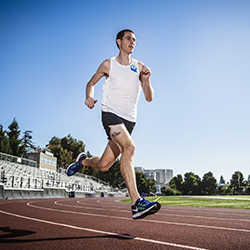APRIL 28TH 2015
BY COACH PATRICK HAMMOND
TIPS FOR TRAIL RUNNING
OutdoorFest a New York city organization, which strives to “connect urban dwellers to local outdoor resources to encourage healthier , active, and more adventurous lifestyles”, interviewed me, Coach Hammond, on “Tips for Trail Running”. Read the interview transcript below or visit the OutdoorFest Blog to see the original post.
You clicked yes on the registration form for a trail race. Your heart floods with excitement, your mind races with thoughts of running over grass, dirt and rocks–when suddenly you realize that most of your running is on the road. How will you prepare yourself for a trail race? Outdoor Fest has answers for you! We sat down with accomplished trail runner Patrick Hammond to talk about it.
For Hammond, trails are his preferred terrain. He grew up running trails behind his home in Kentucky. As of 2014, he entered into ultra running and he has been making a mark in the endurance running community. His accomplishments include:
- 2nd place 2013 North Face Endurance Challenge 13.1 mile at Bear Mt.
- 1st place 2014 North Face Endurance Challenge 13.1 mile at Bear Mt.
- 5th place 2014 North Face Endurance Challenge Marathon in DC
- 2nd place 2014 North Face Endurance Challenge 50K in Wisconsin
Finisher 2014 North Face Endurance Challenge 50 Mile Championships in San FranciscoHammond’s next endurance trail race will be the North Face Endurance Challenge 50 Mile at Bear Mt. on May 2, 2015. In attention to his stellar running career, he is also the co-founder of Educated Running LLC.
Alisha Austin: What have you learned while running trails?
Patrick Hammond: I have learned that it is the best way to escape the noise and just be free. I love to just get lost in the trails and enjoy running. I have also learned that paying attention to how you are feeling and acting on this right away is vital to preventing injury.
A.A.: How do you prepare for trail races?
P.H.: First, I set a long term or outcome goal like a finishing well in a big race. Then, I set several short term or process goals to make sure I am taking the right steps towards my outcome goal. Next, I study the map of the trail to see the terrain/elevation change, so that I can incorporate this knowledge into my training. Third, I listen to my body in order to keep myself healthy and injury free. Last, I keep a positive attitude through my training and always remember that I do this because it is fun and I love it.
A.A.: How would you recommend a person prepare for running a trail run if their weekly mileage is on the road?
P.H: Even in the concrete jungle of NYC you can find some kind of trails. Whether it is bridal path in Central Park, the grassy patches or boulders along the Westside, the hidden trails in Prospect Park, or the miles of trails in Van Cortlandt Park or Palisades Park in NJ— you can find trails. Try to make at least 2 of your runs a week primarily on the trails. Adding runs that involve a lot of elevation change is also helpful because trail runs often involve hills.A.A.: Are there good cross-training exercises that can prepare one for the rigors of trail running?P.H.: Having a strong core and legs becomes even more important in trail running due to the often uneven terrain. Going to yoga or the gym and focusing on your core and stabilizer muscles is key. Mountain biking is also a great way to build strength for trail running.
A.A.: Are there recommended clothing or shoes?
P.H.: Trail shoes should feel snugger in the middle and not allow the heel to slip. Also, make sure you have at least a thumb’s width of space at the front of the shoe. There are many great trail shoes around, so go to a running shop and try them. You may want to start with the trail version of your current road shoe if it exists.
Avoid wearing anything cotton on the trails as this can lead to chaffing and blisters. Dress in layers if you are escaping the city to run some long trails as the temperature can fluctuate in the woods.
A.A.: What trails can a person run in New York City?
P.H.:
- Van Cortlandt Park in the Bronx
- The bridal path or north woods in Central Park
- Sections of Prospect Park in Brooklyn
- Forest and Cunningham Park in Queens
- Greenbelt trail in Staten Island
- Palisades Park in NJ right across the GW bridge.
A.A.: Are there things that experienced trail runners forget that are important not to forget?
P.H.: Bring extra nutrition even solid foods because you burn more fuel on the trails. Plus if you get lost on accident or by choice it’s good to have some extra food and water.
Thanks to Patrick Hammond, you can now approach your trail race with confidence knowing that you have the knowledge to conquer trails safely. Get out there and run!
Alisha Austin is a Graduate student at NYU’s Gallatin School of Individualized Study. She enjoys instant photography, exploring the greenery that NYC has to offer, and building digital and physical things.
ABOUT THE AUTHOR
Coach Hammond
Coach Patrick Hammond earned his Masters Degree in Sports and Performance Psychology from the University of the Rockies. He is a USA Track and Field Level 1 certified coach.
As a runner in college he competed at Western Kentucky University, where he helped his team win a Division IA Cross Country Sun Belt Conference Championship.
- 'This Is What It's Like to Live Under a Running Ban' - In an effort to slow the spread of the coronavirus, many governments have cracked down on the world's most elemental sport. Outside Magazine.
IN OTHER NEWS


